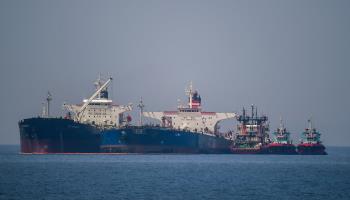By assembling a ‘shadow fleet’ of tankers to export oil, Russia has been able to reduce the impact of G7 sanctions
Western powers have tightened measures designed to reduce Russia’s use of a shadow fleet to export oil. Russia’s shadow fleet is strategically important due to its role in maintaining the country’s position as a leading oil exporter and generating vital export and budget revenues. The fleet has enabled Russia to remove a significant part of its oil exports from the West’s influence, helping Moscow to mitigate sanctions.
What next
Subsidiary Impacts
- The incoming Trump administration could threaten to impose secondary sanctions on buyers of Russian oil.
- Russia will cooperate with OPEC+ to boost global oil prices.
- The old age of shadow fleet vessels will raise the probability of accidents that could cause environmental damage.
Analysis
After Russia’s full-scale invasion of Ukraine in 2022, the United States, the EU and other allied powers targeted Russia’s oil industry by:
- banning imports of most of Russia’s seaborne crude oil and oil products; and
- imposing a price cap of USD60 per barrel on Russian crude oil exports and USD100 for major oil products.
Individuals and companies were prohibited from shipping Russian oil at prices above the levels stated by the cap, with financial, insurance and brokering services denied to those engaged in the trade.
Russia’s response
Moscow announced it would not ship oil to any country adhering to the G7 price cap regulations. Russia quickly assembled a large ‘shadow fleet’ of vessels to maintain its exports of oil and oil products. The shadow fleet includes a ‘grey fleet’ — vessels that obscure their origins and ownership to appear law-abiding — and a ‘dark fleet’ — which includes vessels that obfuscate their origins using techniques such as disabling automatic identification systems or jamming electronic location sensors (“spoofing”).
Rosneft — Russia’s largest oil company — established a network of overseas companies with obscure ownership worldwide, including China, Hong Kong, the Middle East, South-east Asia and Europe. These companies market and sell Russian oil and oil products originating from other states, such as Kazakhstan or Azerbaijan.
The shadow fleet has been increasingly used to transport Russian cargoes after the United States stepped up enforcement of the price cap in October 2023, when the US Treasury started imposing sanctions on companies and identified vessels carrying Russian oil priced above the cap.
Composition of the shadow fleet
The fleet’s vessels are mostly old, with an average age of around 18 years, and one-third estimated to be over 20 years old. Some pose substantial ecological risks. Western insurance companies do not insure them; Russian companies insure, but others have no insurance.
The top destinations for Russia’s shadow fleet vessels are India, China, Turkey and, to a lesser extent, Singapore, Brazil, the United Arab Emirates (UAE) and Bulgaria (see RUSSIA: Oil exports will be tested in future – January 26, 2024). Their oil and oil products are often re-exported to other markets, often with a certificate stating a different national origin. Russian crude oil is also refined in countries such as India and then exported to Europe and other sanctioning countries, including the United States.
The scale of the fleet’s operations
Russian crude oil exports are expected to reach 4.8 million barrels per day (b/d) in 2024, a 0.6% increase from the previous year. The Ministry of Economy expects the average price of exported crude oil to rise to USD70/barrel this year, up from USD64.5 in 2023.
The average price of Russia’s Urals crude blend exceeded the USD60 cap in July 2023, reaching USD80 in September of the same year. In late November 2024, it stood at about USD68.
The total number of vessels in Russia’s shadow fleet is estimated to be more than 600, including nearly 400 oil tankers. Assembling this fleet has reportedly cost around USD10bn since 2022.
399
The number of shadow fleet oil tankers in October 2024
According to Vortexa and Windward, Russia’s grey fleet carried around 1.4 million barrels of crude oil daily between March 2022 and April 2024, a 111% increase from the pre-war level. The volume of oil products shipped rose by 69%.
The volumes carried by the dark fleet increased respectively by 24% (crude) and 17% (products) in the months immediately after the invasion. However, volumes decreased slightly between April 2023 and April 2024 as the grey fleet took most of the load.
The volume of crude oil lifted by the grey and dark fleet combined exceeded 2 million b/d in March 2024 and 1.9 million b/d in April. According to Russian sources, the shadow fleet transported 45% of all Russia’s exported oil in 2023.
By mid-2024, Russia’s shadow fleet transported more than 70% of its oil and oil products, rendering the price cap ineffective, according to the Kyiv School of Economics (KSE). The fleet carried 89% of exported crude oil and 38% of oil products.
A shadow fleet for LNG
Russia has also assembled a shadow fleet to carry LNG (see RUSSIA: LNG ‘dark fleet’ will grow in number – July 22, 2024). Many of its LNG vessels have been re-registered in the UAE and India. According to estimates, they may number around 50, with nine identified as shadow vessels.
In June 2024, the EU adopted measures targeting Russia’s LNG, prohibiting its entities from trans-shipping Russian LNG to non-EU countries and providing related technical assistance and financial and brokering services.
In early August 2024, satellite images captured what was possibly the first shadow LNG tanker Pioneer loading gas from the Russian Arctic. Like oil tankers, the shadow LNG vessels will likely target Asian markets due to the decline in EU natural gas consumption and the prospect of a complete EU ban on Russian LNG imports in the future.
The limits of sanctions
Although sanctioning powers increasingly targeted designated shadow vessels and their operators from late 2023 onwards, the range of targeted ships and companies remains narrow. Russia shields those tankers from sanctions by creating multi-tiered overseas paper companies, making it difficult to trace their true origins (see RUSSIA: Moscow will continue adapting to sanctions – September 25, 2023).
In recent months, the United Kingdom stepped up its efforts, imposing sanctions against ten vessels engaged in the large-scale transportation of Russian oil in violation of sanctions, denying them access to UK ports and cancelling their registration in the UK Ship Directory (see RUSSIA: Ukraine’s allies will target ‘shadow fleet’ – November 26, 2024). Three sanctioned tankers alone — the Nikolai Zuev, Zaliv Aniva and NSA ASIA — were estimated by UK officials to have transported Russian oil worth USD5bn since the start of the invasion.
However, the measures targeting Russia’s shadow exporters have clear limits (see RUSSIA: Oil price cap is unenforceable – April 30, 2024).
On the demand side, influential buyers worldwide, including some in sanctioning countries, have a stake in maintaining the oil trade with Russia. In the complex shadow oil trade schemes, the identities of end buyers as well as sellers are often concealed behind sophisticated networks of shell companies.
Russia’s shadow oil exports also remain integral to the global supply network. Removing Russian oil from the global supply mix increases the risk of supply bottlenecks that could amplify inflationary pressures.



